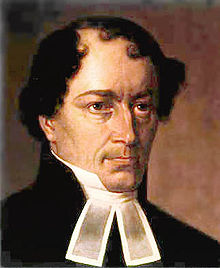Ján Kollár: Difference between revisions
Naming convention |
|||
| Line 2: | Line 2: | ||
{{Merge|Slávy Dcera|date=June 2009}} |
{{Merge|Slávy Dcera|date=June 2009}} |
||
[[Image:Kollar jan.jpg|thumb|right|'''Ján Kollár''']] |
[[Image:Kollar jan.jpg|thumb|right|'''Ján Kollár''']] |
||
'''Ján Kollár''' (29 July 1793 in [[Mošovce]], [[Austrian Empire]] – 24 January 1852 in [[Vienna]], [[Austrian Empire]]) was a [[Slovakia|Slovak]] writer (mainly poet), archaeologist, scientist, politician, and main ideologist of [[Pan-Slavism]]. |
'''Ján Kollár''' (29 July 1793 in [[Mošovce]], [[Royal Hungary|Kingdom of Hungary]], [[Austrian Empire]] – 24 January 1852 in [[Vienna]], [[Austrian Empire]]) was a [[Slovakia|Slovak]] writer (mainly poet), archaeologist, scientist, politician, and main ideologist of [[Pan-Slavism]]. |
||
== Life == |
== Life == |
||
He studied at the Lutheran Lyceum in |
He studied at the Lutheran Lyceum in [[Bratislava|Pressburg]] (then [[Royal Hungary|Kingdom of Hungary]], now [[Bratislava]], [[Slovakia]]). He acted as a pastor in [[Budapest]], since 1849 as a professor of the [[University of Vienna]], and several times as a counsellor to the Austrian government for issues around the [[Slovaks]]. He entered the Slovak national movement in its first phase. |
||
His museum (since 1974) in Mošovce is installed in the former [[granary]], which was the only masoned part of Kollár's otherwise wooden birth-house. The rest of the house burned down in a fire on 16 August 1863. |
His museum (since 1974) in Mošovce is installed in the former [[granary]], which was the only masoned part of Kollár's otherwise wooden birth-house. The rest of the house burned down in a fire on 16 August 1863. |
||
Revision as of 09:56, 29 September 2011
It has been suggested that this article be merged with Slávy Dcera. (Discuss) Proposed since June 2009. |

Ján Kollár (29 July 1793 in Mošovce, Kingdom of Hungary, Austrian Empire – 24 January 1852 in Vienna, Austrian Empire) was a Slovak writer (mainly poet), archaeologist, scientist, politician, and main ideologist of Pan-Slavism.
Life
He studied at the Lutheran Lyceum in Pressburg (then Kingdom of Hungary, now Bratislava, Slovakia). He acted as a pastor in Budapest, since 1849 as a professor of the University of Vienna, and several times as a counsellor to the Austrian government for issues around the Slovaks. He entered the Slovak national movement in its first phase.
His museum (since 1974) in Mošovce is installed in the former granary, which was the only masoned part of Kollár's otherwise wooden birth-house. The rest of the house burned down in a fire on 16 August 1863.
Views
He worked out a conception of Slav reciprocity. He admitted 4 standard languages: Russian, Polish, Czechoslovak and Serbo-Croatian.
Works
Besides writing poetry he also wrote technical literature.
- Slávy Dcera (The daughter of Sláva), collection of two (37 and 39 sonnets) cycles
In this work he worked out the conception of Slavic reciprocity. He expressed his feelings to a woman but this love had transformed to a love to his homeland. The main tematics of this work are: •love •patriotism
It is divided into 5 chapters and it has a foreword.
Předzpěv
The author expressed his fears that the Slovaks will disappear from Europe like other Slavic tribes did it before. He asked the Slovaks to ask for help from the Russian nation.
1. Sála
This part contains love sonnets. He glorified his love and made from her an idol of Slovak women. From this time the girl is Mína,the daughter of goddess Sláva.
2. Labe, Rén, Vltava
In these parts the author took us to places where Slavic tribes lived before. He is disappointed because these areas belong to foreign countries now.
3. Dunaj
The author arrived to Slovakia. He had to see the poverty of this area. He is highly disappointed and he longed for death.
4. Léthé
5. Acheron
Mína, the daughter of goddess Sláva (the author's love), turned into a fairy and took the author to the heaven and to the hell of Slovaks.
- O literární vzájemnosti mezi kmeny a nářečími slavskĭmi (On the literary reciprocity between Slav tribes and vernaculars)
Gallery
-
Statue of Ján Kollár in Mošovce
-
Birth-house of Ján Kollár in Mošovce
-
Motto
-
Museum of Ján Kollár in Mošovce
References
Auty, Robert. 1952. Ján Kollár, 1793-1852. The Slavonic and East European Review Vol. 31, No. 76: 74-91.
External links
- Articles lacking sources from June 2008
- Articles to be merged from June 2009
- 1793 births
- 1852 deaths
- People from Turčianske Teplice District
- Slovak poets
- Slovak scientists
- Slovak politicians
- Slovak philologists
- Slovak linguists
- Slovak philosophers
- Slovak Lutherans
- Mošovce
- European writer stubs
- Slovak people stubs




